Water Quality Parameter Retrieval with GF5-AHSI Imagery for Dianchi Lake (China)
Abstract
1. Introduction
2. Overview of the Study Area and Data Sources
2.1. Overview of the Study Area
2.2. Remote Sensing Data and Preprocessing
2.3. Measured Water Quality Data
3. Research Method
3.1. Water Quality Retrieval Methods
3.1.1. Three-Band Model
3.1.2. Ratio Model
3.2. Pearson’s Correlation Coefficient
3.3. Precision Evaluation Criteria
4. Model Construction and Retrieval
4.1. Spectral Characteristics of Dianchi Water
4.2. Water Quality Parameters and Single-Band Reflectance Correlation Analysis
4.3. Chlorophyll a Model Construction
4.4. Total Phosphorus and Total Nitrogen Model Construction
4.5. Accuracy Assessment
4.6. Retrieval Analysis of Water Quality Parameters
5. Conclusions and Discussion
5.1. Conclusion
- The chlorophyll a retrieval model was constructed using the AHSI GF-5 data, with R2 = 0.852 and RMSE = 0.460 mg/L initially. An accuracy test of the model yielded R2 = 0.943, RMSE = 0.291 mg/L, and MAPE = 7.658%. Overall, the accuracy of this model was higher than that of the model constructed with the WFV GF-1 data, which is consistent with the results of many scholars globally. Therefore, the proposed model can be used for chlorophyll a retrieval in the Dianchi Lake region.
- Under the GF-5 satellite data, the inverse models of total phosphorus and total nitrogen were constructed by using the ratio band method; the R2 values were 0.567 and 0.765, respectively, and the RMSEs were 0.008 mg/L and 0.143 mg/L, respectively. In a precision evaluation, the R2 values of the two test models reached more than 0.8, and the MAPEs were 4.511% and 4.577%, respectively, indicating small errors. Thus, the ratio band model can be used to estimate total phosphorus and total nitrogen levels in Dianchi Lake.
- From the point of view of the spatial distribution, chlorophyll a in Dianchi is mainly distributed in the northern part of the lake, and phosphorus and nitrogen levels are high throughout the water body, with the highest levels in the central and southern parts of the lake. These results indicate that hyperspectral remote sensing data can provide valuable information, spectral data, and band combinations for the retrieval of water quality parameters. The results in this paper further confirm the feasibility of using GF-5 satellite AHSI data for the retrieval of water quality parameters, which is important for relevant departments seeking to perform rapid and efficient monitoring of the water environmental quality of inland lakes.
5.2. Discussion
- This study shows that the AHSI sensor onboard GF-5 is able to provide robust spectral data and a wide range of band combinations, thus enhancing the options for model construction. However, these results may not be completely accurate because they are based on the processing of data acquired from a single satellite image and do not account for seasonal variations and the specific optical properties of the atmosphere, which may impact the results.
- For each water quality parameter, only one model was used in this study, and a comparison of the retrieval ability of different models was not performed. Although the three-band method and the ratio band method are commonly used, more models should be added for comparison in subsequent studies.
- In addition, the limiting factor of semiempirical models in the retrieval of water quality parameters is mainly the synchronization between remote sensing satellite data and measured data. Future research will focus on how to effectively determine the intrinsic optical quantities of Dianchi Lake, such as the absorption coefficient, scattering coefficient, and backscattering coefficient, and use these optical quantities to construct a retrieval model to overcome the limitation of data synchronization.
- The results of this study highlight the significant role that GF-5 hyperspectral remote sensing satellite data play in monitoring the water quality of Dianchi Lake. This study offers a viable and efficient approach for quickly and accurately determining the lake’s water quality status. In the future, with the in-depth study of modern communication technology, wireless internet technology, big data mining, artificial intelligence, distributed measurement, and other technologies, based on the study of the spectral response mechanism of different water quality parameters, it is possible to obtain a better retrieval model, push the monitoring toward networked and intelligent development, and realize online real-time monitoring in the real world. In addition, by combining the advantages of satellite remote sensing, an all-weather, wide-coverage, and early prediction water quality detection system has been established to realize all-round monitoring of water quality.
Author Contributions
Funding
Data Availability Statement
Acknowledgments
Conflicts of Interest
References
- Cao, X.; Zhang, J.; Meng, H.; Lai, Y.; Xu, M. Remote sensing retrieval of water quality parameters in the Yellow River Delta. Ecol. Indic. 2023, 155, 110914. [Google Scholar] [CrossRef]
- Bhateria, R.; Jain, D. Water quality assessment of lake water: A review. Sustain. Water Resour. Manag. 2016, 2, 161–173. [Google Scholar] [CrossRef]
- Wang, L.; Yue, X.; Wang, H.; Ling, K.; Ling, K.; Liu, Y.; Wang, J.; Hong, J.; Pen, W.; Song, H. Dynamic retrieval of inland aquaculture water quality based on UAVs-WSN spectral analysis. Remote Sens. 2020, 12, 402. [Google Scholar] [CrossRef]
- Chebud, Y.; Naja, G.M.; Rivero, R.G.; Melesse, A.M. Water quality monitoring using remote sensing and an artificial neural network. Water Air Soil Pollut. 2012, 223, 4875–4887. [Google Scholar] [CrossRef]
- Xu, J.; Liu, H.; Lin, J.; Lyu, H.; Dong, X.; Li, Y.; Guo, H.; Wang, H. Long-term monitoring particulate composition change in the Great Lakes using MODIS data. Water Res. 2022, 222, 118932. [Google Scholar] [CrossRef] [PubMed]
- Torbick, N.; Hession, S.; Hagen, S.; Wiangwang, N.; Becker, B.; Qi, J. Mapping inland lake water quality across the Lower Peninsula of Michigan using Landsat TM imagery. Int. J. Remote Sens. 2013, 34, 7607–7624. [Google Scholar] [CrossRef]
- Moges, M.A.; Schmitter, P.; Tilahun, S.A.; Ayana, E.K.; Ketema, A.A.; Nigussie, T.E.; Steenhuis, T.S. Water quality assessment by measuring and using Landsat 7 ETM+ images for the current and previous trend perspective: Lake tana Ethiopia. J. Water Resour. Prot. 2017, 9, 1564. [Google Scholar] [CrossRef][Green Version]
- Wheeler, S.M.; Morrissey, L.A.; Levine, S.N.; Livingston, G.P.; Vincent, W.F. Mapping cyanobacterial blooms in Lake Champlain’s Missisquoi Bay using Quick Bird and MERIS satellite data. J. Great Lakes Res. 2012, 38, 68–75. [Google Scholar] [CrossRef]
- Imran, U.; Zaidi, A.; Mahar, R.B.; Khokhar, W.A. Assessment of the lake water quality using Landsat 8 OLI imagery: A case study of Manchar Lake, Pakistan. Arab. J. Geosci. 2022, 15, 1094. [Google Scholar] [CrossRef]
- Hyde, K.J.W.; O’Reilly, J.E.; Oviatt, C.A. Validation of SeaWiFS chlorophyll a in Massachusetts Bay. Cont. Shelf Res. 2007, 27, 1677–1691. [Google Scholar] [CrossRef]
- Reinart, A.; Pierson, D. Water Quality monitoring of Large European Lakes Using MERIS Full Resolution Data. In Proceedings of the 2004 Envisat & ERS Symposium, Salzburg, Austria, 6–10 September 2004. [Google Scholar]
- Al-Shaibah, B.; Liu, X.; Zhang, J.; Tong, Z.; Zhang, M.; El-Zeiny, A.; Faichia, C.; Hussain, M.; Tayyab, M. Modeling water quality parameters using landsat multispectral images: A case study of Erlong lake, northeast China. Remote Sens. 2021, 13, 1603. [Google Scholar] [CrossRef]
- Zhu, X.; Wen, Y.; Li, X.; Yan, F.; Zhao, S. Remote Sensing Retrieval of Typical Water Quality Parameters of a Complex River Network: A Case Study of Qidong’s Rivers. Sustainability 2023, 15, 6948. [Google Scholar] [CrossRef]
- Lu, B.; He, Y.; Dao, P.D. Comparing the performance of multispectral and hyperspectral images for estimating vegetation properties. IEEE J. Sel. Top. Appl. Earth Obs. Remote Sens. 2019, 12, 1784–1797. [Google Scholar] [CrossRef]
- Landgrebe, D. Hyperspectral image data analysis. IEEE Signal Process. Mag. 2002, 19, 17–28. [Google Scholar] [CrossRef]
- Chander, S.; Gujrati, A.; Krishna, A.V.; Sahay, A.; Singh, R.P. Remote sensing of inland water quality: A hyperspectral perspective. In Hyperspectral Remote Sensing; Elsevier: Amsterdam, The Netherlands, 2020; pp. 197–219. [Google Scholar]
- Zang, C.; Shen, F.; Yang, Z. Aquatic Environmental Monitoring of Inland Waters Based on Hyperspectral Remote Sensing. Remote Sens. Nat. Resour. 2021, 33, 45–53. [Google Scholar]
- Liu, H.; Yu, T.; Hu, B.; Hou, X.; Zhang, Z.; Liu, X.; Liu, J.; Wang, X.; Zhong, J.; Tan, Z.; et al. Uav-borne hyperspectral imaging remote sensing system based on acousto-optic tunable filter for water quality monitoring. Remote Sens. 2021, 13, 4069. [Google Scholar] [CrossRef]
- Elsayed, S.; Ibrahim, H.; Hussein, H.; Elsherbiny, O.; Elmetwalli, A.H.; Moghanm, F.S.; Ghoneim, A.M.; Danish, S.; Datta, R.; Gad, M. Assessment of water quality in Lake Qaroun using ground-based remote sensing data and artificial neural networks. Water 2021, 13, 3094. [Google Scholar] [CrossRef]
- Cao, Q.; Yu, G.; Sun, S.; Dou, Y.; Li, H.; Qiao, Z. Monitoring water quality of the Haihe River based on ground-based hyperspectral remote sensing. Water 2021, 14, 22. [Google Scholar] [CrossRef]
- Zhong, Y.; Wang, X.; Wang, S.; Zhang, L. Advances in spaceborne hyperspectral remote sensing in China. Geo-Spat. Inf. Sci. 2021, 24, 95–120. [Google Scholar] [CrossRef]
- Li, S.; Liu, Z.; Liu, K.; Zhao, Z.F. Advances in application of space hyperspectral remote sensing (invited). Infrared Laser Eng. 2019, 48, 303001. [Google Scholar]
- Xiao, C.; Wang, Q.; Wang, M.; Ruan, J.; Chen, M.; Ding, L.; Huang, S. Retrieval of chlorophyll-a concentration in the Yangtze River estuary based on remote sensing data trom GF-5 satellite. J. Donghua Univ. (Nat. Sci. Ed.) 2022, 48, 4. [Google Scholar]
- Deng, S.; Tian, L.; Li, J.; Chen, X.; Sun, Z.; Zhang, L.; Wei, A. A novel chlorophyll-a retrieval model in turbid water for GF-5 satellite hyperspectral sensor—A case in Poyang Lake. J. Cent. China Norm. Univ. (Nat. Sci.) 2018, 52, 409–415. [Google Scholar]
- Wei, A.; Tian, Q.; Chen, L.; Yu, Y. Retrieval and application of Chlorophyll-a concentration in the Poyang Lake based on exhaustion method: A case study of Chinese Gaofen-5 Satellite AHSI data. J. Cent. China Norm. Univ. (Nat. Sci.) 2020, 54, 447–453. [Google Scholar]
- Chen, D.; Fan, J.; Zhao, H.; Gu, B.; Li, X. Empirical Study on Ecosystem Integrity Change and Its Driving Mechanism in Dianchi Lake Basin:1-16. Available online: http://kns.cnki.net/kcms/detail/53.1193.F.20230629.0843.002.html (accessed on 15 September 2023).
- Su, J.; Ji, D.; Lin, M.; Chen, Y.; Sun, Y.; Huo, S.; Zhu, J.; Xi, B. Developing surface water quality standards in China. Resour. Conserv. Recycl. 2017, 117, 294–303. [Google Scholar] [CrossRef]
- Cao, J.; Wen, X.; Luo, D.; Tan, Y. Study on Water Quality Retrieval Model of Dianchi Lake Based on Landsat 8 Data. J. Spectrosc. 2022, 2022, 3341713. [Google Scholar] [CrossRef]
- Liang, Y.; Yin, F.; Xie, D.; Liu, L.; Zhang, Y.; Ashraf, T. Retrieval and Monitoring of the TP Concentration in Taihu Lake Using the Landsat-8 and Sentinel-2 Images. Remote Sens. 2022, 14, 6284. [Google Scholar] [CrossRef]
- Yao, Y.; Zhu, L.; Wu, C.; Zhang, Y.; Wang, P.; Wang, Y.; Chen, J. Water quality remote sensing monitoring research in China based on the HJ-1 satellite data. In Proceedings of the 2010 IEEE International Geoscience and Remote Sensing Symposium, Honolulu, HI, USA, 25–30 July 2010; pp. 620–623. [Google Scholar]
- HJ897-2017; Determination of Chlorophyll a with Spectrophotometry. Ministry of Environmental Protection: Beijing, China, 2017.
- GB11893-89; Determination of Total Phosphorus with Ammonium Molybdate Spectrophotometry. State Bureau of Technical Supervision: Beijing, China, 1989.
- HJ636-2012; Determination of Total Nitrogen with Alkaline Potassium Persulfate Elimination and Ultraviolet Spectrophotometry. Ministry of Environmental Protection: Beijing, China, 2012.
- Zhang, D.; Zeng, S.; He, W. Selection and Quantification of Best Water Quality Indicators Using UAV-Mounted Hyperspectral Data: A Case Focusing on a Local River Network in Suzhou City, China. Sustainability 2022, 14, 16226. [Google Scholar] [CrossRef]
- Lü, H.; Ma, W.C.; Zhou, L.G.; Huai, H.Y. Estimation for water quality parameters in dianshan lake based on HJ-1A HSI image. J. Fudan Univ. (Nat. Sci.) 2013, 52, 238–246. [Google Scholar]
- Huang, Y.; Chen, X.; Liu, Y.; Sun, M.; Chen, H.; Wang, X. Retrieval of river and lake water quality parameters by UAV hyperspectral imaging technology. Yangtze River 2020, 51, 205–212. [Google Scholar]
- Gitelson, A.A.; Gritz, Y.; Merzlyak, M.N. Relationships between leaf chlorophyll content and spectral reflectance and algorithms for non-destructive chlorophyll assessment in higher plant leaves. J. Plant Physiol. 2003, 160, 271–282. [Google Scholar] [CrossRef]
- Gurlin, D.; Gitelson, A.A.; Moses, W.J. Remote estimation of chl-a concentration in turbid productive waters—Return to a simple two-band NIR-red model? Remote Sens. Environ. 2011, 115, 3479–3490. [Google Scholar] [CrossRef]
- Guo, Y.L.; Li, Y.M.; Li, Y.; Lü, H.; Liu, G.; Wang, X.D.; Zhang, S.M. A three band chlorophyll-a concentration estimation model based on GOCI imagery. Huan Jing Ke Xue Huanjing Kexue 2015, 36, 3175–3185. [Google Scholar] [PubMed]
- Dall’Olmo, G.; Gitelson, A.A.; Rundquist, D.C. Towards a unified approach for remote estimation of chlorophyll-a in both terrestrial vegetation and turbid productive waters. Geophys. Res. Lett. 2003, 30, 18. [Google Scholar] [CrossRef]
- Chen, J.; Zhang, L.; Zhang, H.; Zhang, L.; Yi, C.; Tong, Q. Comparative study on the hyperspectral estimation models of TP and TN in Baiyangdian water body. Natl. Remote Sens. Bull. 2023, 27, 1642–1652. [Google Scholar]
- Liu, J.; Kuang, R.Y.; Li, J.X.; Hu, M. Retrieval model of TN, TP concentration based on measured spectral reflectance data in Poyang Lake. Southwest China J. Agric. Sci. 2020, 33, 2088–2094. [Google Scholar]
- Wang, S.; Shen, M.; Liu, W.; Ma, Y.; Shi, H.; Zhang, J.; Liu, D. Developing remote sensing methods for monitoring water quality of alpine rivers on the Tibetan Plateau. GISci. Remote Sens. 2022, 59, 1384–1405. [Google Scholar] [CrossRef]
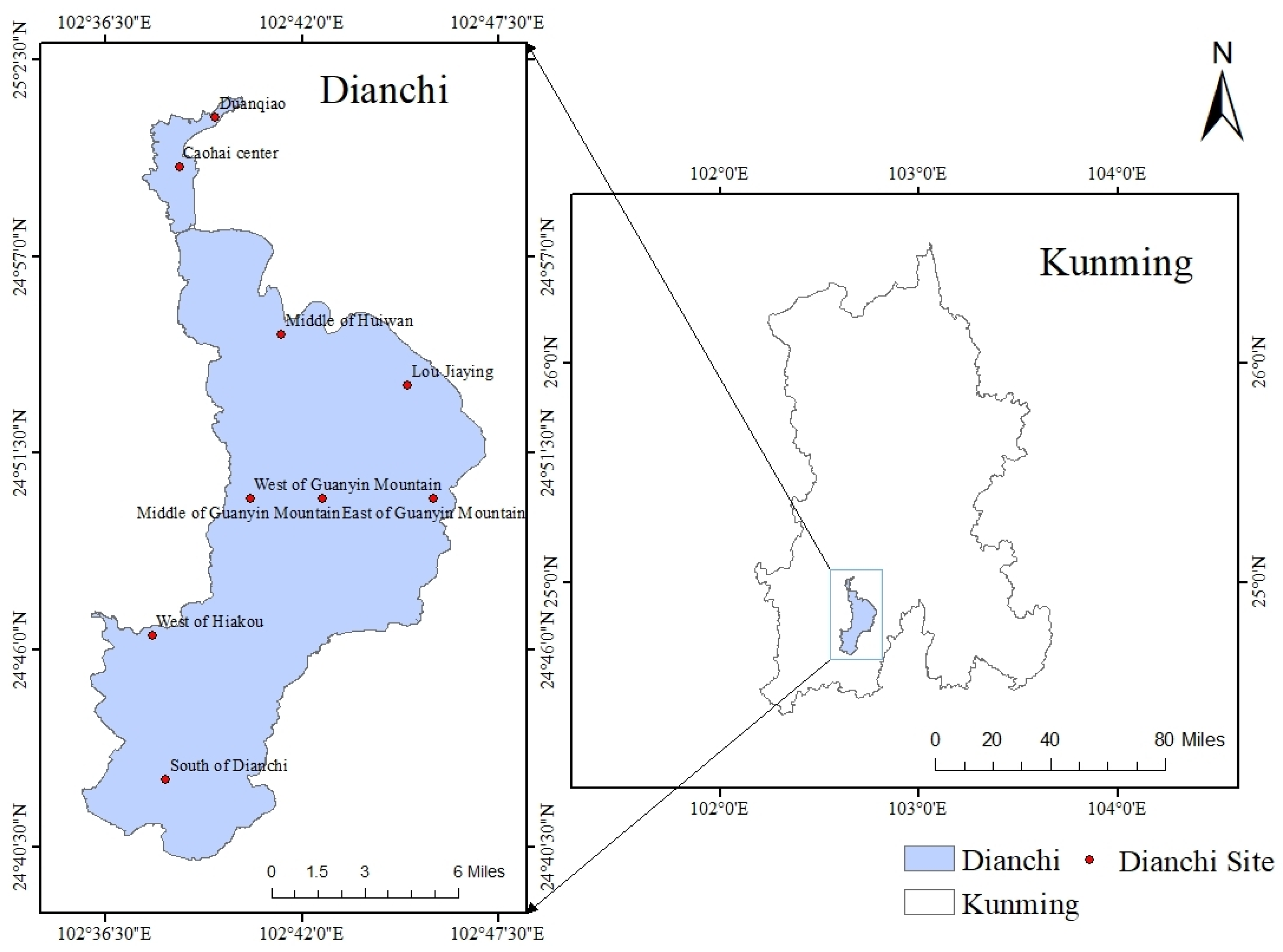
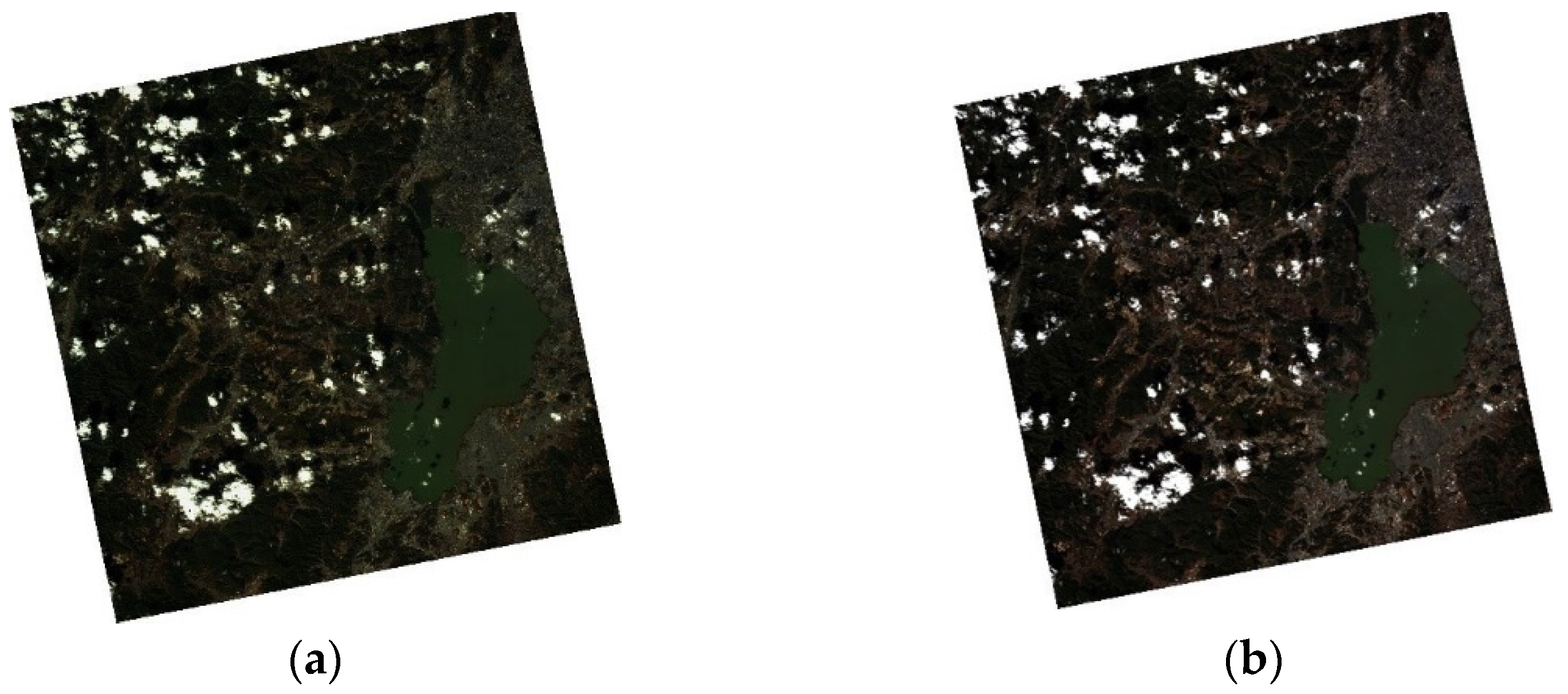
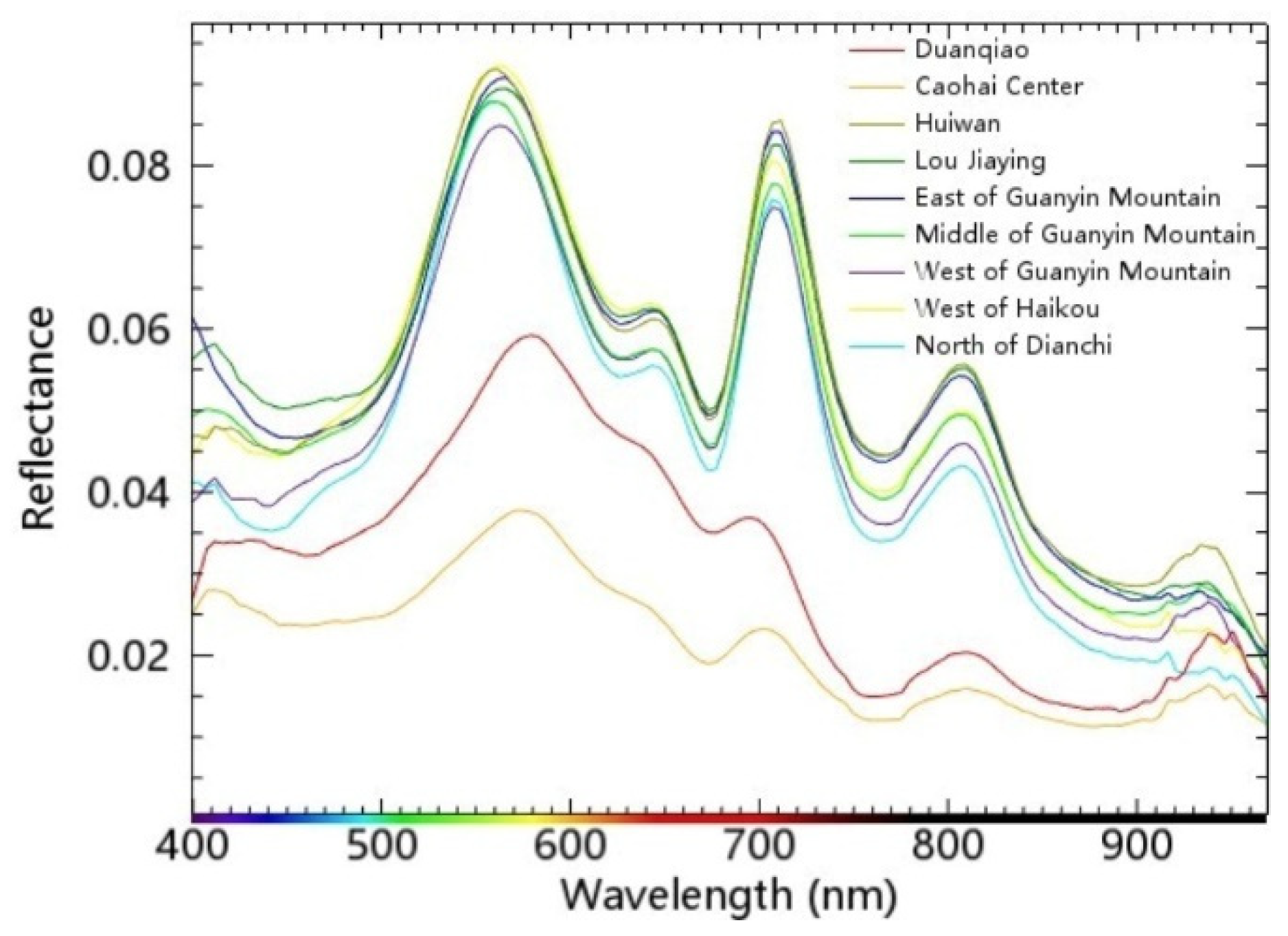
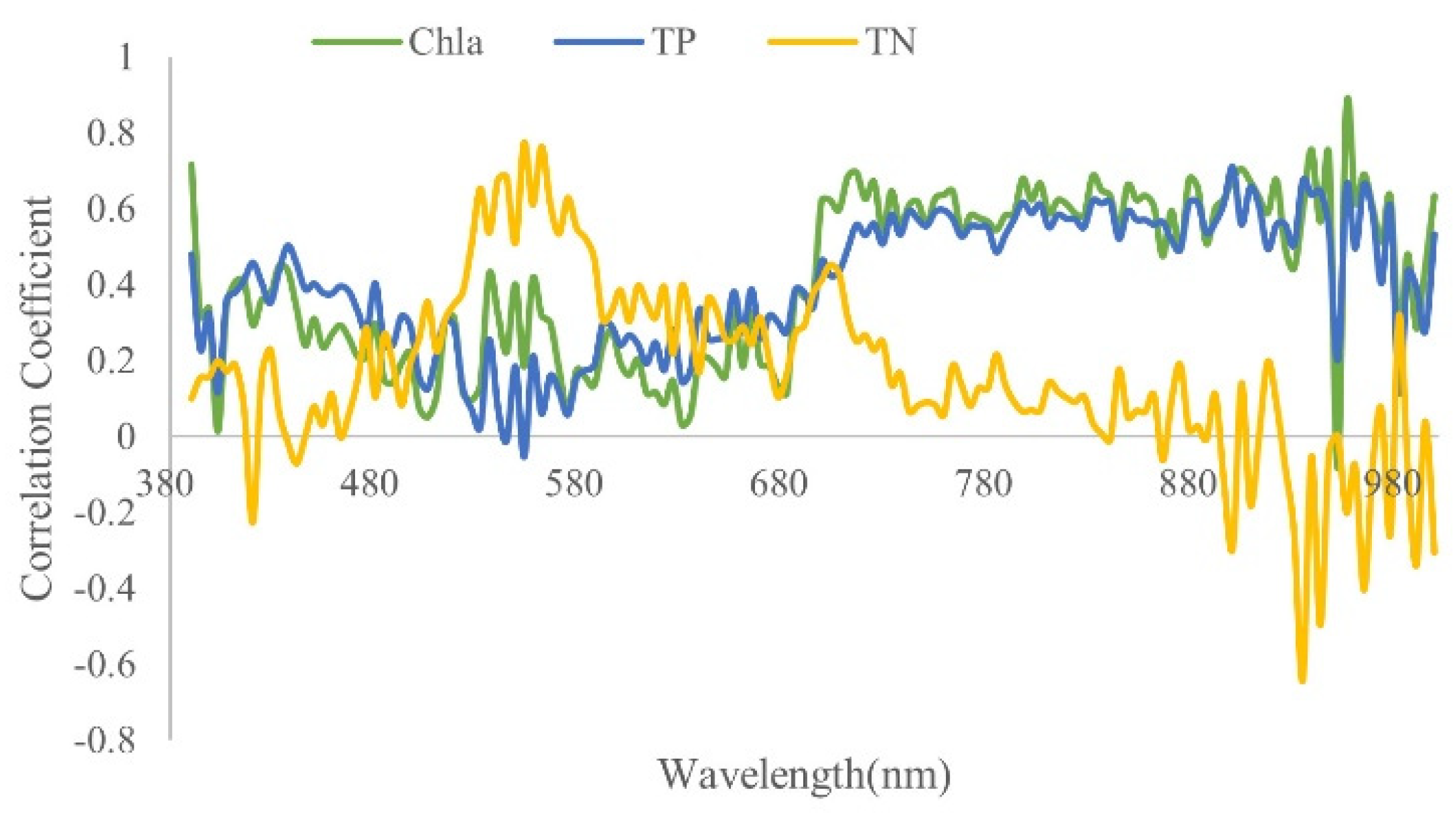

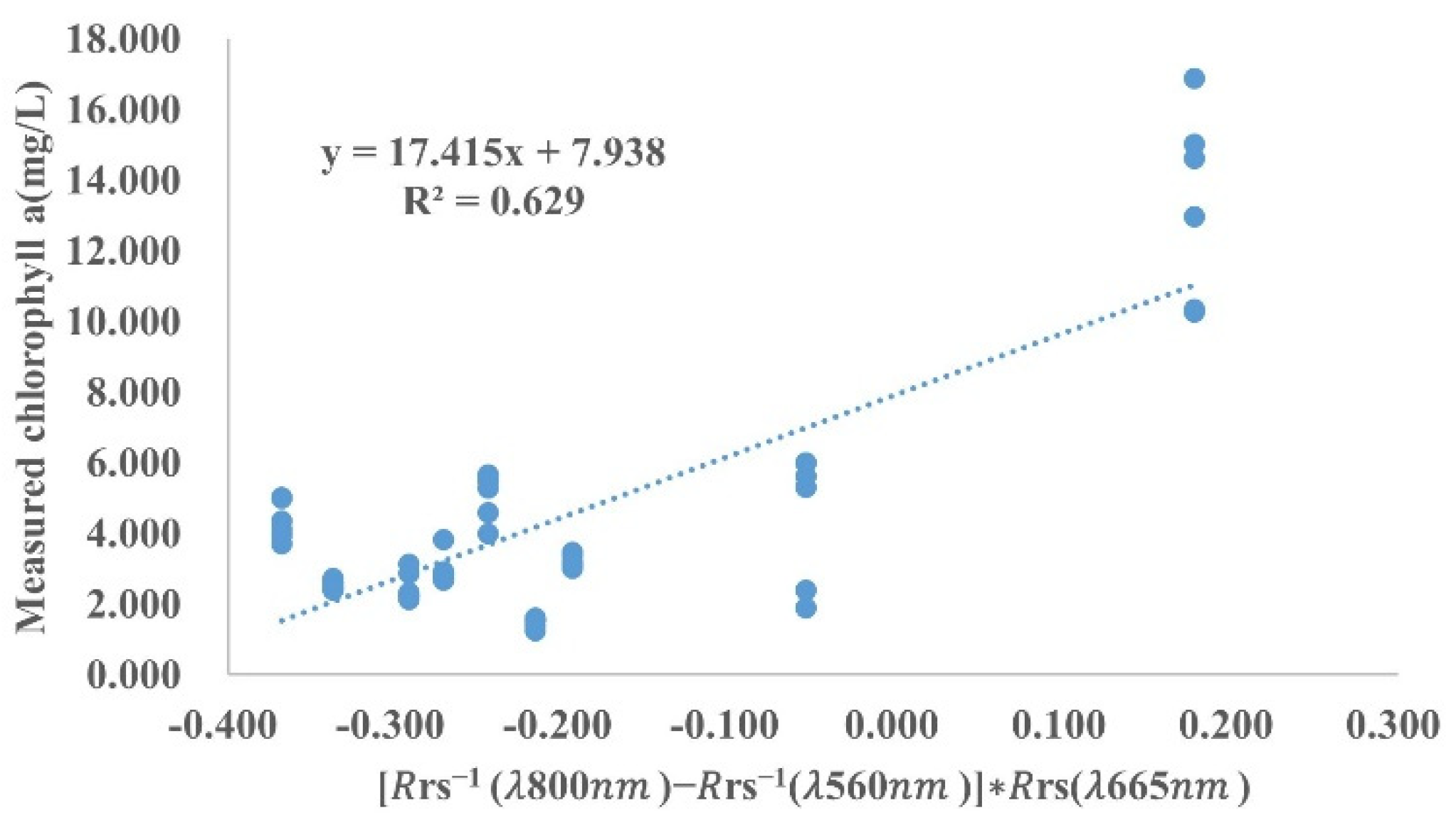
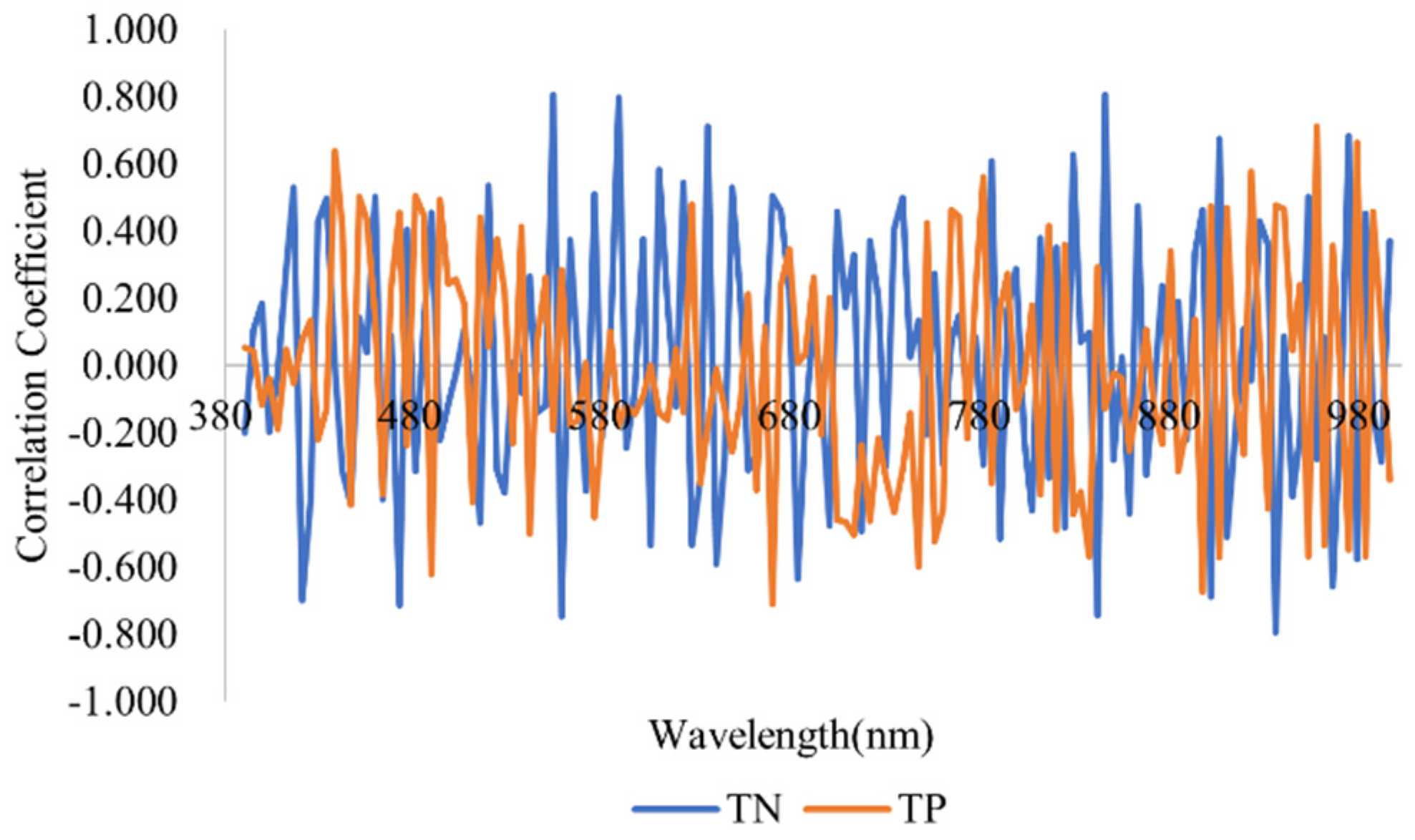



| Sensors | Models | Correlation Coefficient | Coefficient of Determination R2 | RMSE |
|---|---|---|---|---|
| GF-5 AHSI | 0.923 | 0.852 | 0.460 | |
| GF-1 WFV | 0.793 | 0.629 | 2.165 |
| Water Quality Parameter | Molecular Wavelength (nm) | Denominator Wavelength (nm) | Model | Correlation Coefficient |
|---|---|---|---|---|
| TP | 621.5 | 664.1 | 0.752 | |
| TN | 895.1 | 942.2 | 0.875 |
| Sensor | Model | Correlation Coefficient | Coefficient of Determination R2 | RMSE |
|---|---|---|---|---|
| GF-5 AHSI | 0.875 | 0.765 | 0.143 | |
| GF-1 WFV | 0.686 | 0.471 | 0.465 |
| Sensor | Model | Correlation Coefficient | Coefficient of Determination R2 | RMSE |
|---|---|---|---|---|
| GF-5 AHSI | 0.752 | 0.567 | 0.008 | |
| GF-1 WFV | 0.727 | 0.531 | 0.012 |
| Sensors | Formulas | Test Models | Test RMSE | MAPE (%) | |
|---|---|---|---|---|---|
| GF-5 AHSI | 0.943 | 0.291 | 7.658 | ||
| GF-1 WFV | 0.654 | 1.715 | 46.776 |
| Sensors | Formulas | Test Models | Test RMSE | MAPE (%) | |
|---|---|---|---|---|---|
| GF-5 AHSI | 0.841 | 0.005 | 4.511 | ||
| GF-1 WFV | 0.562 | 0.011 | 8.123 |
| Sensors | Formulas | Test Models | Test RMSE | MAPE (%) | |
|---|---|---|---|---|---|
| GF-5 AHSI | 0.884 | 0.203 | 4.577 | ||
| GF-1 WFV | 0.463 | 0.454 | 24.720 |
Disclaimer/Publisher’s Note: The statements, opinions and data contained in all publications are solely those of the individual author(s) and contributor(s) and not of MDPI and/or the editor(s). MDPI and/or the editor(s) disclaim responsibility for any injury to people or property resulting from any ideas, methods, instructions or products referred to in the content. |
© 2024 by the authors. Licensee MDPI, Basel, Switzerland. This article is an open access article distributed under the terms and conditions of the Creative Commons Attribution (CC BY) license (https://creativecommons.org/licenses/by/4.0/).
Share and Cite
Zhang, H.; Hu, W.; Jiao, Y. Water Quality Parameter Retrieval with GF5-AHSI Imagery for Dianchi Lake (China). Water 2024, 16, 225. https://doi.org/10.3390/w16020225
Zhang H, Hu W, Jiao Y. Water Quality Parameter Retrieval with GF5-AHSI Imagery for Dianchi Lake (China). Water. 2024; 16(2):225. https://doi.org/10.3390/w16020225
Chicago/Turabian StyleZhang, Hang, Wenying Hu, and Yuanmei Jiao. 2024. "Water Quality Parameter Retrieval with GF5-AHSI Imagery for Dianchi Lake (China)" Water 16, no. 2: 225. https://doi.org/10.3390/w16020225
APA StyleZhang, H., Hu, W., & Jiao, Y. (2024). Water Quality Parameter Retrieval with GF5-AHSI Imagery for Dianchi Lake (China). Water, 16(2), 225. https://doi.org/10.3390/w16020225






